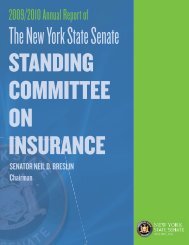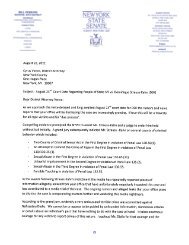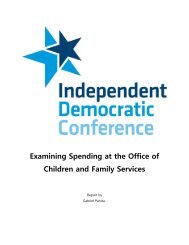Crime Committee Report e.indd - New York State Senate
Crime Committee Report e.indd - New York State Senate
Crime Committee Report e.indd - New York State Senate
Create successful ePaper yourself
Turn your PDF publications into a flip-book with our unique Google optimized e-Paper software.
The Basics of Rockefeller Reform<br />
• z Illegal drugs remain illegal. Adults who sell drugs to children, individuals who use guns<br />
in drug deals are excluded from diversion programs, drug kingpins deserve and to receive<br />
harsh punishment.<br />
• z Discretion is returned to Judges to determine whether or not a defendant should be<br />
diverted to a drug treatment program based on a professional assessment of his or her<br />
health needs and whether or not the candidate is sincere in his or her desire to make a<br />
real change. Mandatory minimum prison sentences for Class B drug offenses and second<br />
time, non-violent drug offenders are ended.<br />
• z A contract is entered into by the defendant and the court.<br />
• z District Attorneys shall still play a key role in assessing appropriate candidates for diversion<br />
but will no longer be able to veto a judge’s discretion.<br />
• z Defendants who fail to complete drug treatment; who fail to cooperate with health care<br />
counselors, who are found to be manipulative or get re-arrested while in treatment can<br />
be expelled from a treatment program and sentenced to probation, local jail or state<br />
prison time.<br />
• z Judges’ discretion to sentence defendants to Willard and Shock Programs is expanded<br />
and the pool of defendants eligible to participate in these “short stay” programs is also<br />
expanded.<br />
• z In addition to these new sentencing options, the new law will give people serving old<br />
indeterminate sentences for Class B level drug convictions the opportunity to apply for<br />
re-sentencing 11 . The re-sentencing part of the new law became effective October 7, 2009.<br />
Inmates with a violent felony conviction within the last ten years are excluded from eligibility.<br />
Approximately, one thousand individuals will be eligible to petition the court for<br />
re-sentencing. At all times it will be in the judge’s discretion to determine eligibility and<br />
how far to go in reducing the sentence.<br />
• z Expand the involvement of the Office of Alcoholism and Substance Abuse Services<br />
(OASAS) into the treatment side of the legislative reforms, both inside prisons and with<br />
outside treatment programs linked to the courts.<br />
Saving the Taxpayers Money<br />
The dramatic change in policy is an attempt to help community members address a major<br />
cause of misconduct, namely substance abuse and chemical dependency, a disease which<br />
requires professional counseling and medical treatment as well as the firm hand of a judge to<br />
maximize the opportunity for continued recovery. At the same time, this change in policy is<br />
contemplated to save the tax payers millions of dollars which can be reinvested into our communities.<br />
It now costs $45,000 a year to incarcerate an inmate in a state prison, and according<br />
to the Department of Correctional Services there are over 13,000 offenders who are in prison<br />
for drug related offenses. Add to that the hope of increased productivity for the people who<br />
succeed in treatment and you will see the vision and great hopes the Democrat Majority has for<br />
family, friends and community members who request a second chance and a helping hand.<br />
11 See the newly created Criminal Procedure Law §440.46<br />
Standing <strong>Committee</strong> on <strong>Crime</strong> Victims, <strong>Crime</strong> and Correction | 2009-2010 <strong>Report</strong> 7


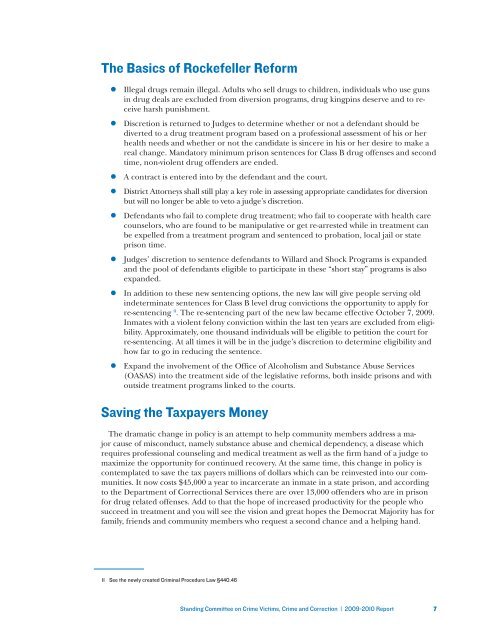
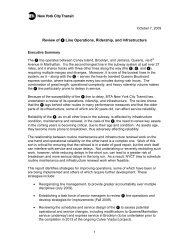



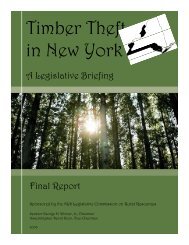

![[PDF] Proposed MTA Capital Program - New York State Senate](https://img.yumpu.com/24854139/1/190x245/pdf-proposed-mta-capital-program-new-york-state-senate.jpg?quality=85)



